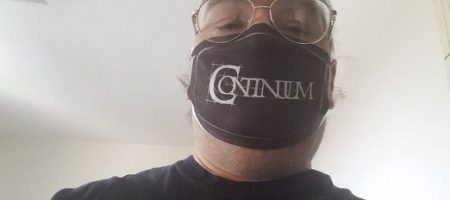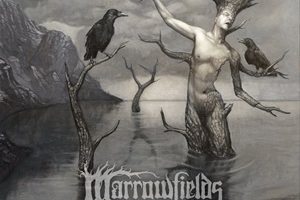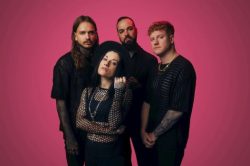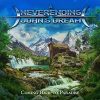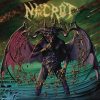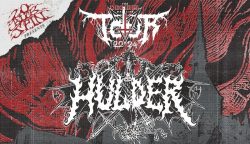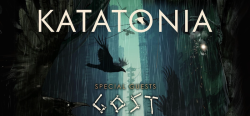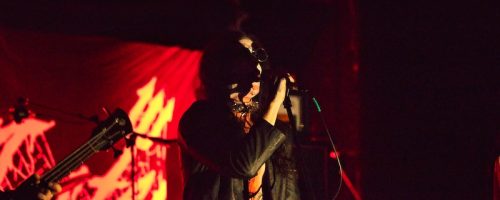Marrowfields – Low, Slow, and Brooding
Saturday, 13th June 2020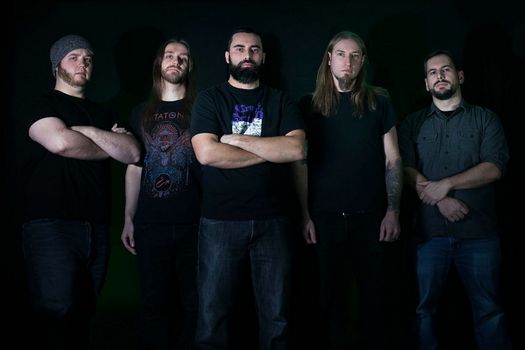
Forming in 2015 originally as a project for guitarist Brandon Green and growing into a full-fledged band over the course of years, Marrowfields is a Massachusetts quintet that perform in the atmospheric doom metal realm. You can expect longer compositions where the musicians explore aspects of traditional, epic riffs, emotional melodies, and transitions that often include aspects of black/extreme nuances beyond the norms of the genre. Cherry picking some of the best musicians around the state, the unit includes drummer AJ Grimes, bassist Tim Cabral, guitarist Josh Moran, and vocalist Ken Gillis – all seasoned musicians with experience in everything from doom to gothic, melodic death to thrash as well as classic heavy metal chops.
The debut album Metamorphoses is a five-song tour de force – one of the best debut albums not only within the New England scene, but for the global atmospheric doom movement. We reached out to Ken and Brandon on Skype one Saturday morning and had an engaging, hour long discussion about the band. Prepare to learn a lot about how the band came together, the songwriting and Ovid/poem-inspired lyrical concepts, thoughts on the cover art and its importance in gaining a record deal, and some thoughts on specific albums/songs that got these musicians through tough times in their lives.
Dead Rhetoric: Tell us about your initial memories of music during childhood – how you discovered heavy metal and when you made the progression to start playing and performing in original bands?
Ken Gillis: My earliest memories are hearing classic rock and hearing bands like Aerosmith, ZZ Top and things like that. The band that I really started getting into metal with was Metallica – I feel like a lot of people that was their first band they got into, especially if you were around my age I guess. And from there it just kind of spread.
Brandon Green: I had a similar kind of experience. I feel like everybody’s first band in metal is Metallica. When I was younger, my mother bought me Master of Puppets on tape, and that was the first Metallica album I got. I was eight or nine, and my mom was a pretty big music buff. She likes southern rock, blues, and she’s big on that. She didn’t get into the crazy metal I did. That was my first gateway and ever since then, I spiraled out of control. You check out who influenced Metallica, and you start getting into the good stuff.
Gillis: That’s what happened to me too. My mom got me into stuff in the car – and Metallica was the gateway to other classic bands. You see where metal kind of went. In so many interesting directions and there are so many avenues you can explore in metal, for everybody, which is one of the reasons why I love the genre so much.
When I was in high school I realized I enjoy singing along to music, and I thought it would be cool to learn an instrument. It wasn’t until I was a freshman in college that I really started doing anything. I picked up a bass and started learning how to play. I met some guys at school that were like-minded and were into all kinds of metal, and I started jamming with them. And that’s where it went. I was 19 when I started playing in bands.
Green: I think I was a similar age. I got my first guitar, it was one crappy Wal-Mart brand, a blue Stratocaster and I remember I had one broken string on it, and it took me a couple of weeks to have full strings. I didn’t have an amp either, so I had this old boombox that I plugged into these RCA jacks. I figured out a way to get an adapter and plug that into my guitar and use the home stereo as an amp. Once I started playing Black Sabbath riffs and getting into playing Metallica riffs, I was hooked and I wanted to be in bands. I switched over to bass for a while because every band I joined, that was a really difficult role to fill. I got the dorky little brother of guitar by playing bass. I kept doing it forever. Pretty much all of our friends are involved in the New England metal scene in some way. In fact, Ken and I have played together a bunch over the last eight to ten years. It’s been an addicting thing ever since – I’m in my 30’s and I don’t think I’m ever going to stop.
Dead Rhetoric: Marrowfields started in late 2015 originally as a project and then blossomed into a full band. How did the process develop over time and the lineup flesh out with the members you currently have?
Green: Sorry if I get a little long-winded here, but it’s a little bit of a story. I’m in another band called The Fateful Hour and that’s very much a band that has a lot of shared responsibilities. I do write some of the material, but everybody writes. Over the course of time I had a bunch of riffs assembled that I thought sounded really cool in a lower tuning, and I’ve never really written for a band that was primarily my work. That was the birth of Marrowfields. At the time I was just starting to get into recording my own music, developing material for my first demo. I wanted to evolve through a different process of sharing the writing with people on the internet. I didn’t really know at the time if I really wanted to do a band with this, so I was programming the drums, Tim Cabral did the bass, there was no vocals. Really dark, melancholic, and melodic music – my wife was part of some of that stuff behind the scenes. It was a fun, artistic piece at first, and I had no expectations of it.
Then as the songs started to take shape, I thought this should be a band. I started thinking about who I wanted to contact. When I wanted to put the lineup together, I wanted to do something totally different. I’ve always been in bands where harsh vocals are king, and there are guitar solos all over the place. Not that I don’t love harsh vocals and guitar solos, but I feel there’s a lot of that stuff and I wanted to explore something new. Ken was the first person I thought of for doing the vocals, I asked him and I didn’t think he was going to say yes. It was easier though to recruit people because I had that demo, I had a whole piece of music that when I cherry-picked people that are the most talented musicians that I love throughout the New England scene, I had a holistic picture of what I wanted to do coming out of the gate.
Josh Moran of Vacant Eyes, I picked because my other band had played with them a bunch of times over the years. I love his playing, where he comes from, he’s a big part of the low and slow movement in terms of playing. He’s a better guitar player than me in a lot of ways with the lead playing, I like to pull somebody in that’s going to bring a completely different perspective. That’s pretty much it. My other secret weapon is my wife- she wrote a lot of leads on the album.
AJ, saving the best for last. AJ was an old friend of mine from high school. We had lost touch for a number of years. He’s been in bands like Norseth, which is actually his high school band that he continued. Him and I shared a love for doom, way back in the day. Our favorite band is Type O Negative, and it’s kind of rare to find a drummer who loves that kind of stuff. We had a good connection, I reached out to him with the demo, he loved it. One of my favorite parts of recruiting him, Tim and I were going to try out drummers and AJ was the main person. When we showed up at his house to try him out, he knew all the songs, we played every single song, first day, first try. We knew immediately he was the guy.
Dead Rhetoric: How did the songwriting and recording process go for the debut full-length Metamorphoses – did you find any specific challenges, obstacles, or surprises take place from the initial demo stages to the final recordings?
Green: There was quite a bit. From the demo stage I was starting to do the bedroom recording thing. At the time I was pretty amateur at it, I’ve learned more over the years. What was cool about it was I got to explore the songwriting again with people who can actually play things a lot better than I can, and do things a lot better than I can. I remember when I sent the songs to Ken, and we set up a studio day, we had not worked together.
Gillis: For me I was used to working with the same guys for a very long time, and they were my closest friends. I get some social anxiety, the idea of working with somebody new was a daunting thing for me because you don’t know how the chemistry is going to be like, or how somebody is going to be to work with. Are they going to be easy going or demanding? After a few minutes of hanging out and getting the songs set up, I knew right away that Brandon was easy to work with and very encouraging, trying different things and patient about the fact that I’m one of those people that likes to get it right. I can nail certain things on a first take, other times I want to try something different. It was great, I really worked on the songs on my own as far as how I wanted to express the vocals on this. He was receptive to it, letting me do my thing. It was a comfortable process.
Green: I knew I wanted clean vocals, but I also told Ken that he didn’t have to do the vocals in the same style as Dreaded Silence, his other band. When he came down, I never asked him this question – were you thinking of doing the same thing, or something new?
Gillis: I knew I was going to do something new. I had an approach I had been wanting to do over time, and it didn’t fit into Dreaded Silence. I had the vocal parts for the last album for years in terms of arrangement and approach. I was happy to be able to fit different vocals into a new project.
Green: We worked on “The Flood” first, and I remember when you came in with the first line, I knew this was going to be sick. It was such a cool experience, that’s the first time I’ve recorded vocals with somebody, the first time I mixed, it started snowballing from there. Once I had the demos, everyone was super excited about it, people were figuring out ways to play their parts differently, let things breathe for the vocals, AJ would push and pull to do his thing. It became a whirlwind thing of writing, and those demos took on a completely un-robotic life of their own after that.
Dead Rhetoric: Considering the epic-length arrangements, are you conscious of the balance necessary to maintain listeners interest while also expressing the needs of the individual song through your atmospheric, doom metal style?
Green: I feel like we have gotten some awesome feedback. I find a lot of people are really loving the record, and I can’t believe that as this is the first sort of album that has circulated the way that it has, I’m pretty happy about it. We did do those things, and I continue to do them. When we write riffs, we think about the chorus hitting really hard, or backing off a little bit before the chorus. We are trying to be cognizant of this as we go through the compositions. Some feedback we’ve gotten is the riffs are monotonous and they don’t develop enough. Part of this genre that I love and wanted to do this is I love the slow burn, I wanted songs that slowly build over time, that add a little bit more interesting drums over two or three repetitions, the leads comes in, the vocals come in. I think it’s a cool staple that we do.
Gillis: From a vocalist perspective as far as approaching that kind of thing, when you have long songs with a repetition of riffs I was lucky as a vocalist they are great riffs. They stood on their own without vocals, and it’s a real challenge as a singer to be able to come up with parts that help lift the song even more when it’s that long and there are that many changes, and you are conscious of keeping the audience interested. It was a tough challenge to make sure I was rising to the occasion, but I tried hard to make sure I could contribute and be a good member of this band.
Green: I think my favorite part of the record that occurred that we sort of stumbled upon was the black metal elements and you doing the clean vocals over that. That was the coolest stuff we have, it’s unexpected. You wouldn’t think a doom record would throw a dreamy blast beat section in there, and there were cool melodic chords where you were doing your own thing on top of that. It made it more intense and visceral. When we wrote “Metamorphoses”, that was the first time that we really started to do it more frequently in the songs. It’s something we are aware of as we are writing. We have eight or nine new songs, and two more in progress.
Dead Rhetoric: Where did you want to come across with the lyrics on this record?
Gillis: Brandon did all the lyrics on this record, and I did some editing, the melodies, and added a line here or there. I’ll be doing the lyrics on the newer material.
Green: I’m super inspired by old folk stories, I love that stuff. I know that’s sort of a trope you see in metal. I wanted to do something that hasn’t been explored- The Odyssey and Dante’s Inferno have been done a million times. One of my other favorite stories is Ovid’s Metamorphoses. I picked five poems from that book, and there’s a lot of poems in that book, that I thought were really cool and write music that sort of mirrors the atmosphere. I wanted the lyrics to be super loose and very vague, to the point where that if someone is reading them, it sort of feels like a poem itself, and you can put the pictures together of what’s happening in the storyline while the music is going. That was pretty deliberate.
Dead Rhetoric: From what I understand, you ended up signing with Black Lion Records as a direct result of the cover art design from Kishor Haulenbeek. What’s the story behind this piece, and where do you see the importance of cover art and metal today compared to say your early introduction to the genre?
Green: Oh man. For me, when I was a kid and Newbury Comics was still a thing and they were all over the place, Friday nights after school we would go to the movies and there would be a Newbury Comics next door. What I loved to do is peruse the metal section, metal would be blasting and you would see the cover art. When something grabs your eye, that’s what is going to make you take it home and check it out. I think cover art is one of the most important things, and it’s the biggest reason why Black Lion picked us up because it’s such a piece that speaks for itself. It looks like the album, and it was cool as he’s a good friend of mine. I sent the record to Kishor ahead of time, and I told him to just roll with it. I trust him, he’s a great artist – when he sent me that thing back, I was absolutely floored. It’s perfect in every way. A big desolate landscape that’s flooded and it’s showing the punishment of mankind through transformation, and there’s even a crow and a raven on the cover.
In terms it was such a big deal for us, when we made all our marketing materials and showcased that as the main piece with the music, that’s how Black Lion could get into what we were doing at a pretty quick pace.
Dead Rhetoric: How would you describe Marrowfields when it comes to your live performance versus the studio work? What do you hope the audience is able to take in and grasp, and what have been some of the more memorable performances to date?
Gillis: The last show we did is where things came together the best. The thing with us is, we haven’t played a ton of shows. The first couple of years we played one show a year, and then we got to a couple of shows in the same month. It’s hard to develop that live chemistry, and we only rehearse when we have a show on the horizon. With everybody being so spread out, Josh in western Mass., Brandon in Fall River, I’m in the Boston area, Tim in Plymouth, and AJ is central Mass. The more we’ve done it, the better we’ve gotten. We try to build the atmosphere of the songs into our live performances. Also, make sure there’s a lot of energy in that. As a vocalist and frontman, I try to lighten the mood in between songs and say something funny a little bit. I think the highlight was performing our newest song at that show – it’s my favorite song we’ve done to date.
Green: Yeah, we slayed at that show. I was having a couple of equipment issues but we still sounded great. We sold a lot of merch, and it was a pretty packed venue. It was a Providence show, an evening of Dark Arts that showcased visual components and other performers beyond music. We had a belly dancer friend that performed, she did costumes with skulls and furs. There were painters, visual artists, tattoo artists, and it was a big mixing pot of stuff in one night. When we played we gave it our all. That show is where we came into our own, and we will strive to improve upon that. We want to do a little more of the epic, traditional heavy metal sound in our sound.
Dead Rhetoric: Brandon you also have a YouTube channel with Ben from your other band The Fateful Hour called Metal Forge Reviews. Can you tell us about the channel and what you want to achieve with this work – as it seems like a mixture between reviews, interviews, and thought pieces?
Green: So, thanks for asking about it. I’m glad this dorky little thing has some interest! (laughs). It’s a fun thing. Ben and I have always celebrated the metal scene in some way. We always love going to shows, buying bands merchandise, supporting the underdogs and all of that stuff. When we initially started the show, it was a way of us trying to give back in a way. We want to bring light to everybody who is doing really cool stuff that may not necessarily get some sort of attention. If somebody’s thinks it’s cool, maybe that person will get a new subscriber. It’s a big melting pot way of discussing new releases.
It’s been a blast. I’ve known Ben since we were 16. We’ve always worked on stuff together, and he’s always had a background in video, that’s what he studied. Now we just divide responsibilities and make it happen. Even in the first few weeks of doing this, we are already getting cool album submissions from bands, interview some interesting people with Cam from Spell and with Chris Naughton from Winterfylleth, that guy was so cool to talk to. I love the behind the scenes stuff, I think people will appreciate the art form more when they hear how much work goes into things.
Metal Forge Reviews Channel on YouTube
Pages: 1 2











